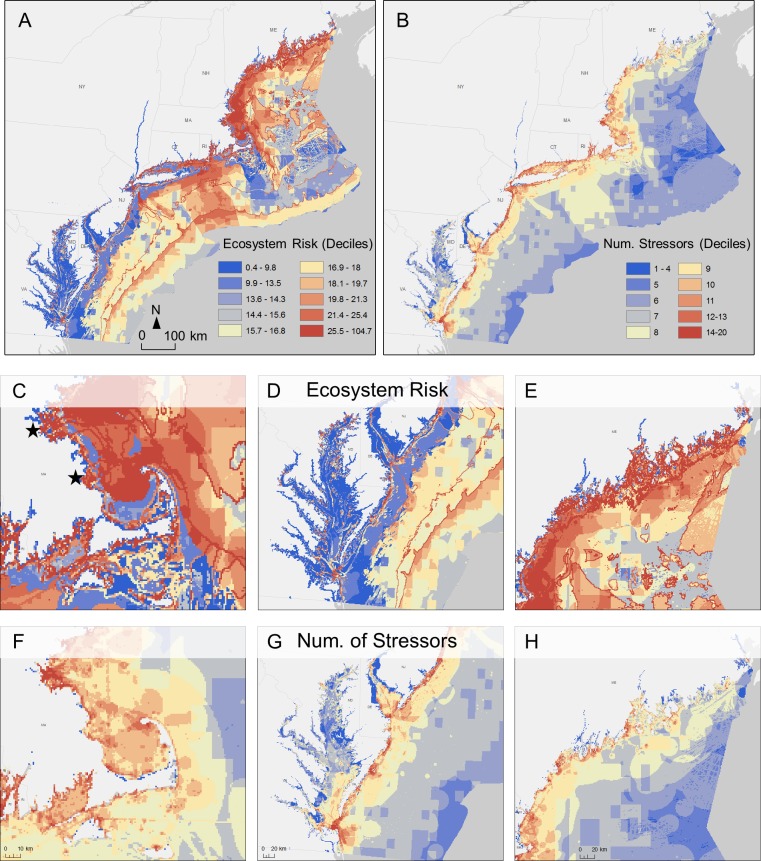Coastal habitats present necessary advantages to folks, together with habitat for species focused by fisheries and alternatives for tourism and recreation. Yet, such human actions can also imperil these habitats and undermine the ecosystem companies they supply to folks.
Cumulative risk assessment supplies an analytical framework for synthesizing the affect of a number of stressors throughout habitats and decision-support for balancing human makes use of and ecosystem well being. To discover cumulative risk to habitats in the U.S. Northeast and Mid-Atlantic Ocean Planning areas, we apply the open-source InVEST Habitat Risk Assessment mannequin to 13 habitats and 31 stressors in an exposure-consequence framework.
In doing so, we advance the science priorities of EBM and each regional planning our bodies by synthesizing the wealth of accessible knowledge to enhance our understanding of human makes use of and how they have an effect on marine sources. We discover that risk to ecosystems is biggest first, alongside the coast, the place a lot of stressors happen in shut proximity and secondly, alongside the continental shelf, the place fewer, increased consequence actions happen. Habitats at biggest risk embody comfortable and hard-bottom nearshore areas, tidal flats, soft-bottom shelf habitat, and rocky intertidal zones-with the diploma of risk various spatially. Across all habitats, our outcomes point out that rising sea floor temperatures, business fishing, and delivery persistently and disproportionally contribute to risk.
Further, our findings counsel that administration in the nearshore would require concurrently addressing the temporal and spatial overlap in addition to depth of a number of human actions and that administration in the offshore requires extra focused efforts to scale back publicity from particular threats.
We provide a clear, generalizable strategy to evaluating cumulative risk to a number of habitats and illustrate the spatially heterogeneous nature of impacts alongside the japanese Atlantic coast and the significance of spatial scale in estimating such impacts.
These outcomes provide a useful decision-support device by serving to to constrain the choice house, focus consideration on habitats and places at the biggest risk, and spotlight impact administration methods.

Sediment file of polycyclic fragrant hydrocarbons in the Liaohe River Delta wetland, Northeast China: Implications for regional inhabitants migration and financial improvement.
The polycyclic fragrant hydrocarbons (PAHs) of a 210Pb-dated sediment core extracted from the Liaohe River Delta wetland have been measured to reconstruct the sediment file of PAHs and its response to human exercise for the previous 300 years in Northeast China. The concentrations of the 16 U.S.
Environmental Protection Agency precedence PAHs (∑16PAHs) ranged from 46 to 1167 ng g-1 in this sediment core. The concentrations of the 16 PAHs (particularly 4- and 5+6-ring PAHs) after the 1980s (floor sediments 0-6 cm) have been one or two orders of magnitudes increased than these of the down-core samples.
The exponential development of 4-ring and 5+6-ring PAH concentrations after the 1980s responded nicely to the elevated vitality consumption and variety of civil automobiles ensuing from the speedy financial improvement in China.
Prior to 1950, comparatively low ranges of the 16 PAHs and a excessive proportion of two+3-ring PAHs was indicative of biomass burning as the foremost supply of the PAHs. A big enhance in the 2 + Three ring PAH focus from the 1860s-1920s was noticed and may very well be attributed to a continuing inflow of inhabitants migration into Northeast China.
It was urged that the hyperlink between historic development of PAHs and inhabitants or vitality use includes two totally different financial levels. Typically, in an agricultural financial system, the higher the inhabitants measurement, the higher the emission of PAHs from biomass burning, whereas in an industrial financial system, the enhance in sedimentary PAH concentrations is carefully associated to growing vitality consumption of fossil fuels.
